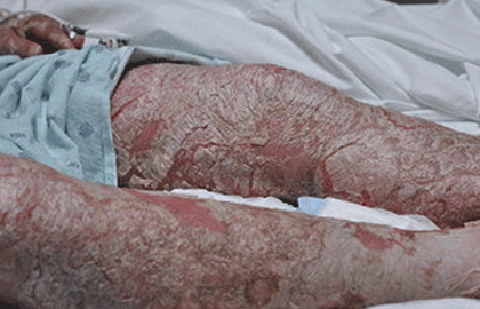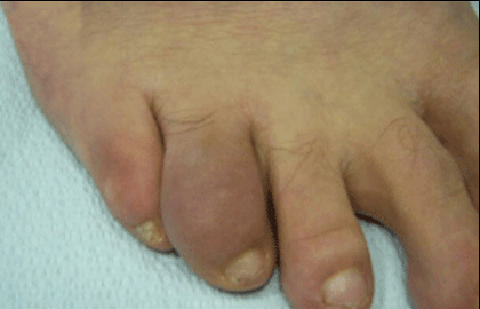PSORIASIS AND ITS HOMEOPATHY MANAGEMENT…….
PSORIASIS
Psoriasis causes symptoms such as scaly, dry, or itchy skin. There’s no cure, but identifying your triggers, taking medications, and making lifestyle changes can all help you manage your symptoms.
Psoriasis is a chronic autoimmune condition that causes the rapid buildup of your skin cells. This buildup of cells causes scaling on your skin’s surface.
Inflammation and redness around the scales are fairly common. Typical psoriatic scales are whitish-silver and develop in thick, red patches. However, on darker skin tones, they can also appear more as purplish, dark brown with gray scales. Sometimes, these patches will crack and bleed.
Psoriasis is the result of a sped-up skin production process. Typically, skin cells grow deep in your skin and slowly rise to the surface. Eventually, they fall off. The typical life cycle of a skin cell is 1 month.
In people with psoriasis, this production process may occur in just a few days. Because of this, skin cells don’t have time to fall off. This rapid overproduction leads to the buildup of skin cells.
Scales typically develop on joints, such as elbows and knees. However, they may develop anywhere on your body, including the:
- hands
- feet
- neck
- scalp
- face
Less common types of psoriasis affect the:
- nails
- mouth
- area around the genitals.
commonly associated with several other conditions, including:
There are several forms of psoriasis. The sections below will look at some of these in more detail.
Plaque psoriasis
About
Plaque psoriasis occurs most often on the elbows, knees, scalp, and lower back.
Inverse psoriasis
Inverse psoriasis is a variant of psoriasis that develops in skin folds. It
- the armpits
- the groin
- the areas under the breasts
- other skin folds, such as those around the genitals and buttocks
Inverse psoriasis typically produces lesions without the scales that occur in plaque psoriasis. The lesions might be smooth and shiny.
Irritation from rubbing and sweating can make this type of psoriasis worse due to its location in skin folds and tender areas. It is more common among people who are overweight and those with deep skin folds.
Erythrodermic psoriasis
Erythrodermic psoriasis is a type of psoriasis that can cause large areas of inflammation across the body. The condition is rare and affects around
In addition to severe inflammation, a person with erythrodermic psoriasis may experience severe itching, pain, and large-scale skin shedding.
Erythrodermic psoriasis also disrupts the body’s chemical balance. This interference may cause protein and fluid loss that can lead to the person developing severe complications such as pneumonia and congestive heart failure.
Edema, or swelling from fluid retention, may also occur, especially around the ankles. The body may also have difficulty regulating its temperature, which can cause shivering.
The complications of erythrodermic psoriasis can be dangerous. Anyone with any symptoms of this condition should contact a doctor right away. A person with erythrodermic psoriasis may need to spend time in the hospital if the symptoms are severe.
Guttate psoriasis
Guttate psoriasis is more common in children and adolescents than adults. It accounts for
It appears as small, individual spots on the skin. The spots are not usually as thick or as crusty as the lesions in plaque psoriasis.
A range of conditions can trigger guttate psoriasis, including:
- upper respiratory infections
- streptococcal infections
- tonsillitis
- stress
- injury to the skin
- certain medications, including antimalarials, lithium, and beta-blockers
Guttate psoriasis may resolve without treatment and never return. However, it may clear up and reappear later as patches of plaque psoriasis.
Pustular psoriasis
Pustular psoriasis is a
Pustular psoriasis tends to have a cycle in which the formation of pustules and scaling follows the discoloration of the skin.
Although psoriasis can form anywhere on the human body, below are some of the most common areas.
Pustular psoriasis (generalized)

Serious and life-threatening, this rare type of psoriasis causes pus-filled bumps to develop on much of the skin. Also called von Zumbusch psoriasis, a flare-up causes this sequence of events:
Anyone with pustular psoriasis also feels very sick, and may develop a fever, headache, muscle weakness, and other symptoms. Medical care is often necessary to save the person’s life.
Nail psoriasis

While many people think of psoriasis as a skin disease, you can see signs of it elsewhere on the body. Many people who have psoriasis see signs of the disease on their nails. With any type of psoriasis, you may see changes to your fingernails or toenails.
When psoriasis affects the nails, you may notice:
CAUSES….
Although the cause of psoriasis is still unclear, scientists believe that it is an autoimmune condition. Autoimmune conditions affect the immune system, which produces T cells to protect the body against infectious agents.
In people with psoriasis, triggers can lead to their genes instructing the immune system to target the wrong cells. T cells respond to a trigger as if they are fighting an infection or healing a wound. They produce chemicals that cause inflammation.
In psoriasis, this autoimmune activity leads to the excessive growth of skin cells. Typically, skin cells take about 1 month to replace themselves. However, in people with psoriasis, they take around 3–4 days to do this.
Triggers will be different in each individual with psoriasis, but some common triggersinclude:
- stress and anxiety
- skin injuries
- infections
- hormonal changes
Medications that can trigger a psoriasis flare include:
- lithium
- antimalarials
- quinidine
- indomethacin
Importantly, psoriasis is not contagious. Knowing and remembering this can help people with the condition cope with the parts of socializing that they may find difficult.
SYMPTOMS….
Psoriasis plaques can range from a few spots of dandruff-like scaling to major eruptions that cover large areas. The disease’s symptoms and appearance vary according to the type and severity of psoriasis.










Comments
Post a Comment